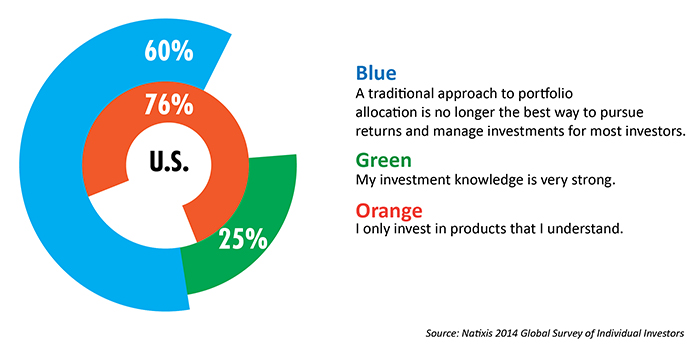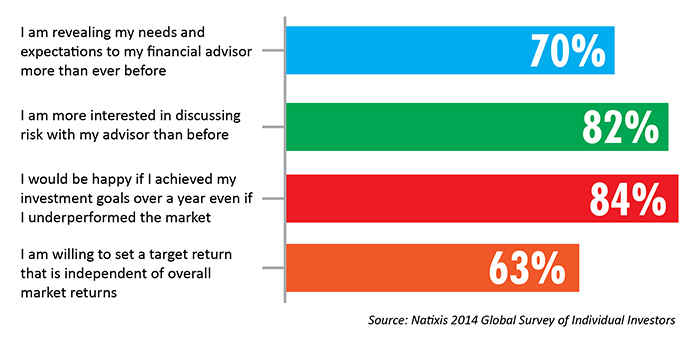Investors looking for answers
Investors looking for answers

Investors are demanding increased risk management for their investments, representing an increasingly growing market for actively managed strategies.
These surveys reported responses from thousands of individuals with at least $200,000 in net worth. Fourteen developed countries were represented in 2014 and 17 in 2015. U.S. investors constituted 18% of the sample in 2014 and 11% in 2015. Although this article looks primarily at the U.S. responses, the surveys show considerable similarity in investor attitudes across countries, maintaining that “despite several years passing since the financial crisis, investors around the world are still highly risk averse.”
“Market volatility has eroded confidence in the markets for two-thirds (66%) of investors worldwide. For example, four in ten (41%) say that achieving stable returns amid market volatility is most important in their investment decision-making, yet only 19% of investors are very confident their current investment approach will protect their portfolio from dramatic swings in value, and only about one-half (55%) cite being knowledgeable about investment strategies that produce stable returns/income.”
Among the most interesting results of the surveys is the belief among U.S. investors that the traditional approach to portfolio allocation is not the best way to invest.

Research findings
- A majority of investors lack confidence that their current investment approach can deliver on the objectives they need. They would like to be more confident in the ability of their investment approach to protect from swings in value, preserve capital, achieve diversification, take advantage of bull market periods, protect from inflation, grow their portfolios, and provide income in retirement.
- 53% of American investors are willing to take only a minimal amount of risk, even if it means sacrificing returns.
- 84% of American investors would take safety over performance if forced to choose, an increase from 78% in 2014.
- 65% of Americans see market volatility as a factor that undermines their ability to reach their savings and retirement goals.
- Close to 20% of U.S. investors think that most investments are “a pure gamble.”
- Investors said they need to earn average gains of 9% above inflation annually to meet their financial requirements—a historically unrealistic rate of growth.
Turn the first bullet point around and the result fits well with the broad objectives of a holistic approach to active investment management. Active management, based on technical analysis and dynamic risk management, is designed to reduce volatility, preserve capital, achieve diversification, take advantage of bull market periods, provide return levels that protect from inflation, grow portfolios, and ultimately provide income in retirement. Can actively managed strategies return 9%-plus inflation? Only time and market conditions can fully answer that question, but certainly the potential exists over the long run.
The Natixis survey results show a majority of investors are dissatisfied with their current investment approach, with 60% in 2014 (increasing to 70% in 2015) saying traditional stock and bond approaches are no longer enough to pursue returns and manage risk. While the surveys do not specifically define that approach, traditional passive asset allocation is no doubt the most likely current choice for most investors. For active-management proponents, it comes as no surprise that passive allocation approaches fail to protect investors from severe market declines. Capitalizing on bull-market periods, while still protecting portfolios from down-market volatility, requires an investment strategy that adapts to current market conditions.
What are the implications?
- Investors are not blindly accepting buy-and-hold and passive asset-allocation investing as the only way to investment success. They are looking for better answers.
- The potential market for active management that meets the investor’s need to balance risk and return is enormous.
- Managing risk matters. Marketing risk management used to be considered a nonstarter. People, it was maintained, invest to generate return—not to manage risk. This survey illustrates that investors are far more concerned with capital preservation than optimizing return.
- There is a strong interest in understanding and being able to measure investing risk. This changes the parameters of the investment decision. The emphasis is not on the historical performance of an investment class but on the volatility and risk-reward profile of that performance.
- Investors want to understand the investment approach. Active management needs to be presented in a manner that makes sense to the investor. “Black boxes” and overly complex approaches are going to be a harder sell versus a more digestible explanation of the broad objectives for actively managed portfolios.

More investors are also turning to investment advisors for assistance, which is a finding in-line with other major studies and likely reflects—to some degree—the aging demographic of the boomer generation. According to the research findings, “Globally and generally, investors who use a financial advisor are more likely than those without one to have clear investment goals, a financial plan for reaching them, stronger investment knowledge, and greater tolerance for risk.”
For advocates of active investment management, these results provide further evidence that individual investors recognize the risks of investing and are open to strategies that allow them to achieve reasonable returns along with capital preservation. And, for advisors considering expanding their offerings to include active, third-party money management, the surveys clearly demonstrate a great demand for the benefits that a sophisticated active investment approach can offer.
PERSONAL BENCHMARKING
U.S. Investors

“The stakes are high for investors who now face perpetual volatility in the market and new, bigger risks to their financial security, particularly in retirement. The path forward calls for a change in investors’ approach to investing, one that includes a new understanding of risk and reward, more meaningful performance benchmarks, and disciplined involvement in the investment process with an advisor who understands their goals and personal risk tolerance. It is an approach that manages risk by using it as a portfolio advantage, rather than a necessary evil of investing.”
The opinions expressed in this article are those of the author and do not necessarily represent the views of Proactive Advisor Magazine. These opinions are presented for educational purposes only.
 Linda Ferentchak is the president of Financial Communications Associates. Ms. Ferentchak has worked in financial industry communications since 1979 and has an extensive background in investment and money-management philosophies and strategies. She is a member of the Business Marketing Association and holds the APR accreditation from the Public Relations Society of America. Her work has received numerous awards, including the American Marketing Association’s Gold Peak award. activemanagersresource.com
Linda Ferentchak is the president of Financial Communications Associates. Ms. Ferentchak has worked in financial industry communications since 1979 and has an extensive background in investment and money-management philosophies and strategies. She is a member of the Business Marketing Association and holds the APR accreditation from the Public Relations Society of America. Her work has received numerous awards, including the American Marketing Association’s Gold Peak award. activemanagersresource.com
